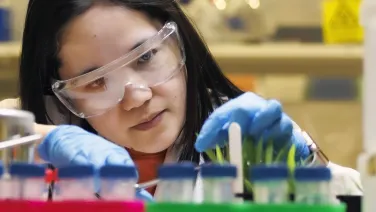
Photosynthesis and plant energy biology
About
The capture of CO2 by photosynthesis using sunlight is fundamental to the maintenance of life on earth. At the Research School of Biology, we study the energy metabolism of plants, algae and cyanobacteria, including the functioning of light capture, CO2 fixation and the interactions with respiration processes and how these determine growth and productivity of agricultural and natural ecosystems.
Our approaches range from synthetic biology to physiology and plant phenomics. The ANU node of the Australian Plant Phenomics Facility is developing new modeling and machine learning approaches to enables us to scale from leaf to field. This means we can translate our knowledge about the biochemistry and physiology of leaves and individual plants to their functioning in agroecosystems, in particular under changing climatic conditions.
Our research is embedded in the ARC Centre of Excellence for Translational Photosynthesis, the ARC Centre of Excellence in Plant Energy Biology, as well as the Bill and Melinda Gates-funded C4 Rice and RIPE (Realizing Increased Photosynthetic Efficiency) projects.






















